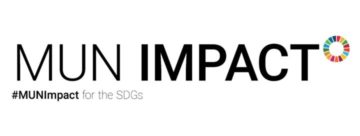MUN Refugee Challenge-Promoting Refugee Awareness through Model UN
Pauline Eluère works in Strategic Communications for the United Nations High Commissioner for Refugees. The UN Refugee Agency is mandated to protect the 70.8 million people who have been forced to leave their homes. Ms. Eluère presented other statistics to educate her presenters. There are currently 26 million refugees- people who have had to leave their homes due to violence. There are 45.7 million internally displaced people who have been forced to move within their home country and need protection. There are 4.2 million asylum seekers- people who are in the process of getting their refugee status in a country.
The UNHRC headquarters is located in Geneva, and their priorities are explained by 3 pillars. Ms. Eluère presented a graphic that showed three boxes, saying “help, hope, home” respectively. The first pillar focuses on “help,” which is providing humanitarian aid, right to territory and asylum to victims. The second pillar focuses on “hope,” which is providing solidarity, education, jobs for those in need. The last pillar is “home,” which focuses on the return, resettlement, and local integration of refugees.
Next, Ms. Eluère showed a very poignant video explaining the refugee crisis around the world. The video was very informative and titled, “where do refugees come from?.” For example, it stated that in 2014, most of the world’s refugees came from Syria. Furthermore, another main country where refugees come from is Myanmar. This was due to the Rohingya crisis in 2015. The crisis included the forcible displacement of Hindu and Muslim Myanmar nationals. Ms. Eluère stated that the majority of refugees cross the border and escape to neighboring countries. In fact, 73% of refugees are hosted in neighbouring countries, and 85% of refugees are hosted in developing countries. Ms. Eluère explained that refugees are “just like us.” Anyone can be in a situation where war or conflict requires them to flee their homes to seek protection.
Then Ms. Eluère focused her presentation on the impact of Covid-19 on the refugee crisis. Many of the displaced communities are “particularly vulnerable to the virus due to overcrowding, limited access to health systems,” and hygiene. She mentioned that the virus has been identified in dozens of refugee camps across the globe, and so this is a very major challenge in developing countries. To prevent the spread of the virus in refugee camps, UNHCR members ensure the availability of sanitation facilities and testing kits.
What can governments do to help with the refugee crisis? Ms Eluère explains that they must give refugees access to hospitals and health care. Furthermore, they must include refugees in economic recovery plans, as refugees are civilians and need support. Governments should also donate to improve conditions in camps and support local organizations working to alleviate the refugee crisis.
Ms. Eluère mentioned that refugees are “not just victims, they are also real people.” They are resilient and are fighting for a better world. “They are part of the solution,” and must be protected for a better, more united, and peaceful world. To conclude her presentation, Ms. Eluère talked about how students can help. Some tips she gave was to “volunteer locally to help refugees integrate,” “learn a language with a refugee,” and donate to organizations tackling the refugee crisis.
Everyone can participate in the MUN refugee challenge. Students can find solutions for refugees during their MUN conferences and submit their resolutions to UNHCR. So far more than 20,000 students have been involved. The best ones will be shared with policy makers. 80,000 students will get to meet UNHCR colleagues or refugees.
